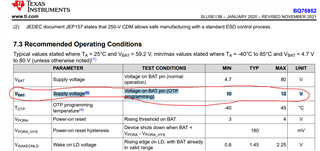Other Parts Discussed in Thread: BQSTUDIO, EV2400
Tool/software:
Hi,
We made a custom board using the BQ76952 for a 13S battery pack. I am trying to bring it up and test whether it works.
I initially tried the step mentioned in the EVM User Guide. Where I powered using a lab-bench power supply. Provided 32V - 48V on the 13S+ cell connection and 0V (GND) on the BAT- pin. I was expecting 32-48V on the PACK+ and PACK- pins. But unfortunately, it was 0V. Not sure if something is wrong? I didn't have anything connected on the other cell connections.
I'm attaching the schematic of our board, if you notice anything off? I followed the 2-layer reference design provided in the BQ76952 reference design section.
How would I go about testing this board? If you have any suggestions?
Thanks again for all your help.



